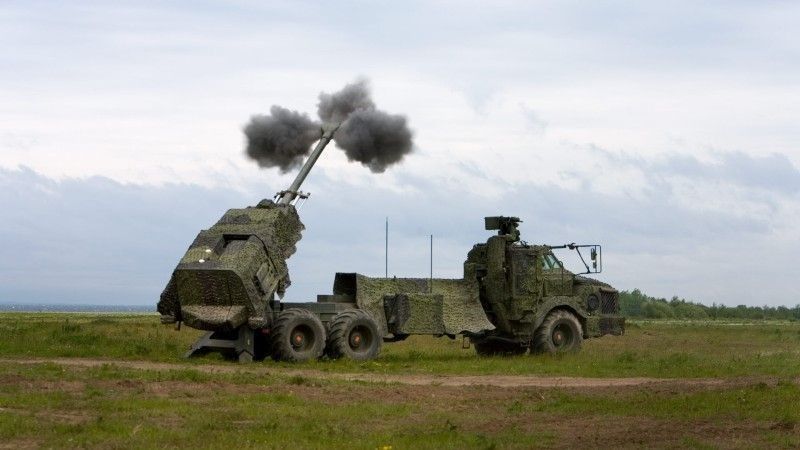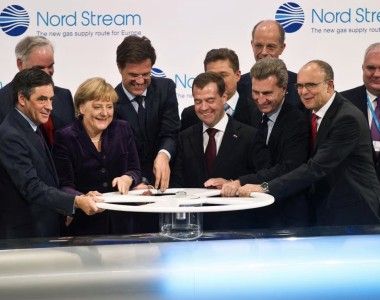Europe Buys Munitions for Ukraine: A Good First Step, but Much More is Needed

The European Union has decided to allocate more than EUR 2 billion for refunding of deliveries, purchases and capacity increase for the manufacturing of ammunition for Ukraine. For now, there is no decision to support purchases from United States. Defence24 has received an in-depth explanations on this issue from the European Commission Spokesperson Office. This is a good step, but Europe has to do much more.
Recently, ministers of Defence and Foreign Affairs have agreed to a framework for joint procurement of 155 mm ammunition (and missiles, if requested by the Ukraine). As Ukraine urgently needs munitions, as well as other types of military equipment, this may be viewed as a good step. At the starting point, as many as 17 Member States and Norway decided to take part in the project on 155 mm artillery munitions, including Austria, Belgium, Croatia, Cyprus, Czechia, Estonia, Finland, France, Germany, Greece, Luxembourg, Malta, the Netherlands, Portugal, Romania, Slovakia, Sweden. As of now, Poland and Spain are also on board, and it is likely other countries will join as well.
According to the EC Spokesperson Office:
The EU has agreed on a three-track approach proposed to speed up the delivery and joint procurement aiming at one million rounds of artillery ammunition for Ukraine in a joint effort within the next twelve months.
EC Spokesperson Office
"The three-track approach consists of:
- €1 billion from the European Peace Facility for the reimbursement to the Member States who immediately deliver any type of ammunition (and missiles if requested by Ukraine).
- Another €1 billion under the European Peace Facility to reimburse joint procurement of 155mm ammunition (and missiles if requested by Ukraine), from the European defence industry and from Norway. This will be done through a project led by the European Defence Agency or by a lead-Nation's framework. 17 EU Member States plus Norway signed a project arrangement for a project with the European Defence Agency dedicated to joint procurement of 155mm ammunition.
- Support measures to rapidly ramp up the manufacturing capacities and reduce production time of the European defence industry to replenish stocks for Ukraine and for EU Member States" - as the Spokesperson added.
It has not yet been decided, which facilities will be used to produce the 155 mm munitions. As the Spokesperson notes: "It is too early to talk about a "selection" of producers. In general, what we can say is that there are at least 11 Member States which currently host 155mm ammunition producers, and 12 if we also take into account the 152mm soviet calibre still used by Ukraine. Their supply chain is also encompassing other Member States. In respect of the most pressing need concerning the supply of 155mm ammunition preliminary findings confirm that the EU industry has a significant potential in production capacity of 155mm ammunition to address both EU Member States demand and the one of Ukraine".
For now, Internal Market Commisioner Thierry Berton has visiting various facilities to discuss the procurements. So, the details are being worked out but in principle the aim is quite clear: to jointly procure up to 1 million of 155 mm shells, spend another 1 million for reimbursements of EU Member States from existing stocks, and thirdly – to use EU mechanisms to support capacity expansion.
Financing
As the EU budget cannot be used to buy weapons, as the Spokesperson Office pointed out, it is worth looking at financing options. The system currently used is the European Peace Facility, launched in 2021: "Under the European Peace Facility, the EU has been supporting the delivery of Member States' ammunition and other military equipment to Ukraine since Russia launched its war of aggression against Ukraine. When it comes to joint procurement, the European Peace Facility can also be used to support joint procurement efforts that are for the benefit of Ukraine (or other third countries)." – the Spokesperson said
EPF is being filled with agreed donations of Member States. Before the decision of allocating EUR 2 bn for munitions procurement, EUR 3.6 billion had been allocated under EPF, and the total amount of what Member States have done bilaterally for Ukraine is approx. EUR 13 billion (so now, it may be up to 15 billion). This may seem much, considering that the both the EU and the Member States stepped its effort to engage in Ukraine security assistance only recently. It is however, far from being enough.
In comparison, the security aid provided to Ukraine since the full-scale Russian aggression against Ukraine provided by the US amounts for 32.5 USD billion in the already allocated funding including drawdowns from the US Armed Forces inventory (more than USD 19 billion, usually replaced by new equipment) and USAI/FMF contracts directly for Ukraine, for approx. USD 13 billion. This equals to nearly EUR 30 billion, and we need to remember that this is the funding already allocated (committed), the total amount appropriated by Congress in FY 2022 and FY 2023 is more than USD 45 billion.
Thus, the (sad) fact is that US is now spending more for the support of defence of Ukraine (security assistance) than the Europe is. While somehow at the beginning of the full-scale war it could have been somehow justified, as Europe simply did not have enough equipment / ammo stocks to draw from, it is not sustainable in long term. We need to refer to the debate in the US (not only among the Republicans to be honest) to understand that. However, had we been able to reverse those proportions (with the majority of security aid, i.e. 30 EUR billion or more per annum paid from Europe, and the rest from non-EU countries), it would have been easier to convince US to stay engaged, which is a long-term strategic interest in from Europe.
On the top of that, even now more and more aid is coming in the form of contracts awarded specifically for the use by Ukraine (in US: USAI) rather than drawdowns from existing stocks, simply because we have reached a point where you need to produce or procure equipment rather than grant it from existing military stocks. The European economy is more than capable of providing Ukraine long-term annual defence aid on the scale that has until recently been provided by US. For context, USD 34 bn is approx. GDP 0,2% of EU (taking into account the World Bank estimate of EU GDP being more than 17 billion).
So, there is a clear need for Europe to stand up to that challenge. There might be a need for use extraordinary mechanisms (perhaps Member States could use unused loans from Recovery Fund to pay additional contributions to European Peace Facility), but it should be possible. Another challenge in the coming months and years will be providing Ukraine with sustainment of various kinds of equipment (also non-EU produced, like M109 howitzers, Bradley IFV, Patriot and HIMARS along with munitions etc.). This is additional area where flexible regulatory framework, providing Ukraine with funding and thus continuous support for all sophisticated and varied systems it has.
This should not be excluding joint ventures, like in the case of COMLOG GmbH where both Raytheon and MBDA Deutschland participate to sustain Patriot, but US FMS shall not be excluded either. And it is feasible for EU to protect its own industrial base and support the already delivered US-made systems, for instance by preparing special cooperative funding agreements for sustainment certain capabilities that have been delivered to Ukraine, without all-out opening of EU security assistance to US prime contractors.
Even after the full-scale war is finished, the Ukrainian economy might not be able to pay for sustainment of such a broad range of different. Thus, the EU will have to step up, otherwise a risk of a repeated full-scale aggression from Russia will persist, and that needs to be avoided. Asked by Defence24.pl on whether the EU consider would stepping up assistance for Ukraine in supporting US-made systems is US had reduced its engagement, the Spokesperson has said: "We remain committed to support Ukraine for as long as it is needed and for as long as it takes".
Another issue is financing the industry capacity expansion. While this may seem controversial, in my humble opinion it is not the most difficult part, as opposed to procurement of actual weapons plus sustainment. We already have some success stories here (for instance with Piorun MANPADS in Poland, where the yearly capacity is being increased from 300 missiles in 2021 to 1500 missiles in 2024 or Caesar howitzers in France, where the capacity is being increased from 24 to 96 howitzers per annum). There are obvious challenges, such as personnel, components and machinery availability, but those can be overcome over time.
At the very least it will be easier to get the money, as per Commission Spokesperson:
On the use of the EU budget to support industrial ramp-up Commission is looking at all options, and in particular that of mobilising EDIRPA. This is the €500 m facility put on the table recently that could be used to accelerate the pace of industrial production of these ammunitions. The financial sector should recognize their contribution is crucial, including the European Investment Bank (EIB). The Commission is in regular contact with EIB covering a wide range of issues, including on requests for it to consider adapting its lending its policy to support the Defence Industry
EC Spokesperson Office
In the end, Europe will need both to sustain its own Armed Forces and finance sustainment of the Ukrainian Armed Forces as well as expand its industrial base. In short, there is a long way to go, and current agreement might only be seen as the first step.



